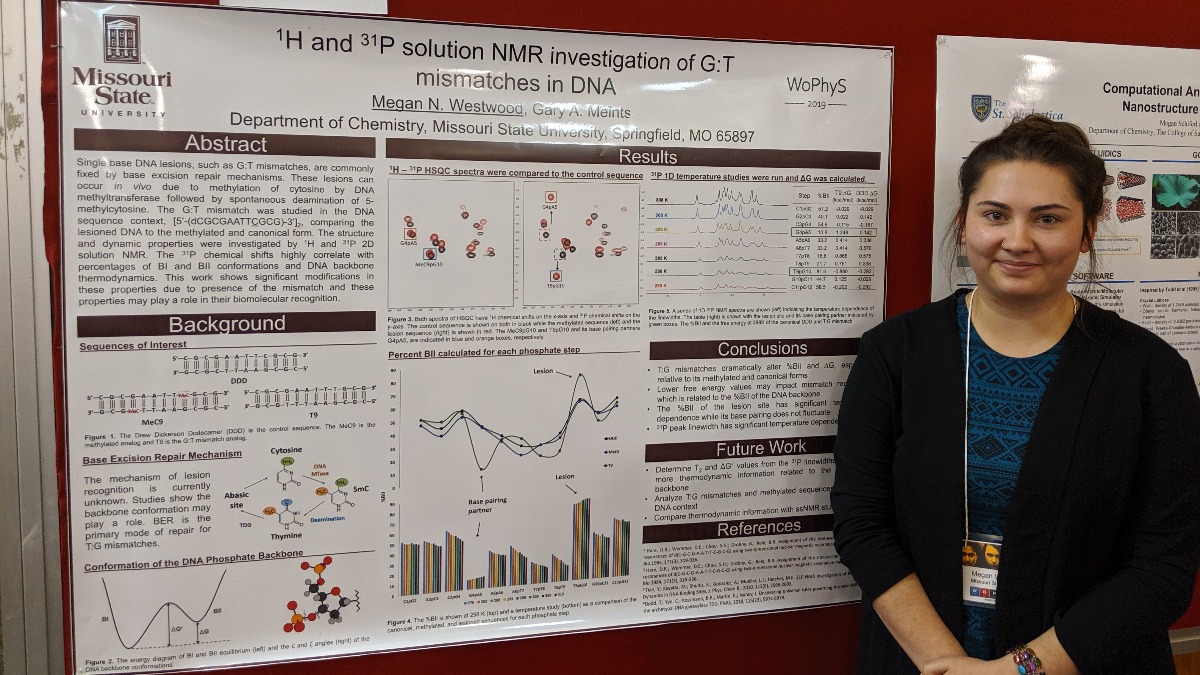There’s power in representation.
This is true of women in Science, Technology, Engineering and Mathematics (STEM).
Graduate student Megan Westwood is among those representing women in the chemistry department at Missouri State University.
She recently made Compound Chemistry’s list of 100 notable women in chemistry.
Westwood shares details of her research that led to the recognition. She also delves into the sources of support she has a found as a woman in the sciences at Missouri State.
Bringing recognition to the details of DNA
Even the body can make mistakes, particularly when sequencing DNA.
The body has proven capable of fixing such mistakes. But questions surround the mechanics at play in the repair process.
“Before the body can fix a problem, it must know how to recognize them,” Westwood said. “If we can figure out how recognition occurs within the cell, we can learn how the body initiates the repair process.”
Her research could provide insight needed to prevent and treat diseases.
“Errors that don’t get caught can end up causing mutations and cancers,” Westwood said. “This makes understanding the DNA recognition and repair process key knowledge to future medical interventions.”
Westwood and other researchers from the MSU chemistry department recently published a collaborative paper on their research findings. She served as a first author of the publication.
Dr. Gary Meints, associate professor of chemistry and Westwood’s advisor, was also a contributor and runs the research lab.
Advocating for women’s representation in STEM
Women have historically been underrepresented in STEM disciplines.
MSU is making strides in addressing these disparities at the faculty level with the NSF ADVANCE catalyst project.
This can make a significant impact in shaping students’ experience with leadership in the classroom, as Westwood has encountered firsthand.
“I had a student mention to me that she was excited to have me as a female teaching assistant, as she had never had one before,” she said. “That was an eye-opening experience.”
Westwood hopes she and other female students in the chemistry department can make a difference as future leaders in the field.
“Having few contributors of women’s perspective in the sciences leads those few to become the voice of entire communities of women. Such a limited presence can’t adequately represent women as a whole,” Westwood said.
“The many women at the undergraduate and graduate level in our program can offer needed presence to further generations of female scientists.”
Learn more about Westwood’s research
Finding support, building an alliance
Reaching change can come from spreading awareness of the discrepancies between genders.
It can also result from having community support, which Westwood has found in her peers and professors, she shares.
“I’m especially grateful for the support offered by Dr. Meints as my advisor,” she said. “He has helped me prepare to face the difficulties related to underrepresentation I will encounter in the field, which has fueled my professional development.”
Westwood has learned that such support in the chemistry department extends to recognizing the varying statuses of women’s identities.
This includes many as members of the LGBTQ community. Westwood is a member of the community herself.
“There’s growing diversity in the chemistry department at MSU,” Westwood said, “and the department’s community as a whole has been such a strong ally of women and LGBTQ in STEM.”
Explore the chemistry department
Discover more from CNAS NewsWatch
Subscribe to get the latest posts sent to your email.

